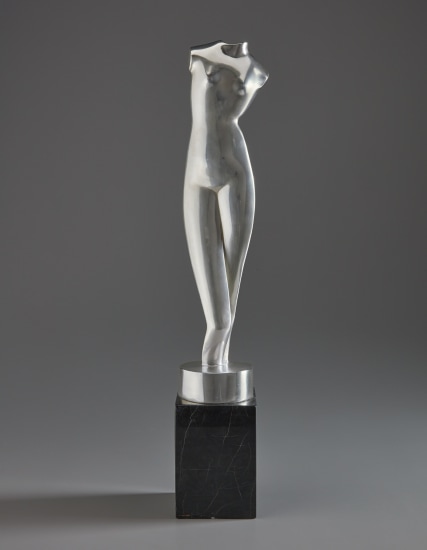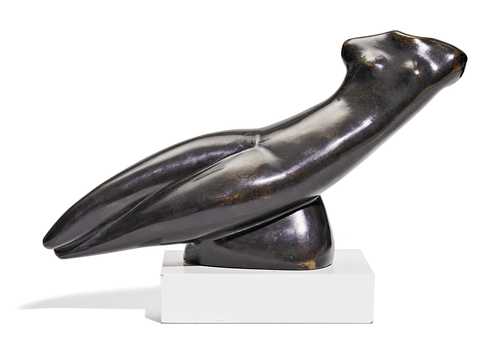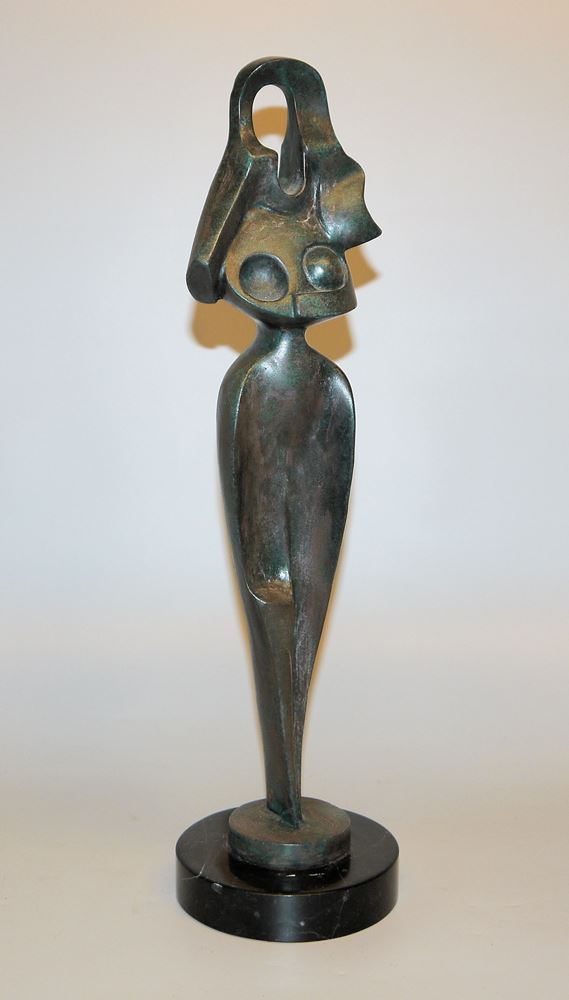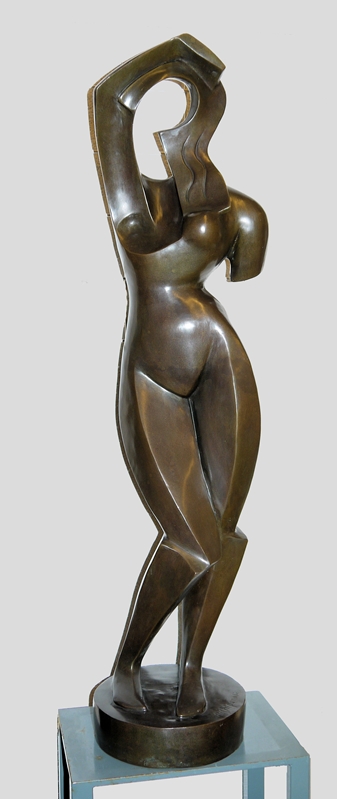Property from The Museum of Modern Art, New York, Sold to Benefit the Acquisitions Fund Alexander Archipenko White Torso stamped "Archipenko...T FDRY NY" on the base silvered bronze 18 1/2 x 4 x 4 in. (47 x 10.2 x 10.2 cm.) Conceived in 1916, this work was executed in bronze circa 1920. Frances Archipenko Gray has confirmed the authenticity of this work.
Provenance Mr. and Mrs. Murray Thompson The Museum of Modern Art, New York (gifted by the above in 1961) Exhibited New York, The Museum of Modern Art, Recent Acquisitions, December 19, 1961 - February 25, 1962 New York, The Museum of Modern Art; The Art Gallery of Ontario, Alexander Archipenko The Parisian Years, July 20, 1970 - March, 1972, cat. no 25 (illustrated, The Museum of Modern Art), cat. no. 20 (illustrated, The Art Gallery of Ontario) Literature New York, The Anderson Galleries, Archipenko: Catalogue of Exhibition and Description of Archipentura, 1928, cat. no. 24 (another silvered example exhibited and illustrated) Donald Karshan, ed., Archipenko: International Visionary, Washington D.C., 1969, cat. no. 30, pl. 104, pp. 72-73 (a bronze example exhibited with a silvered example illustrated as installed at Saks Fifth Avenue, 1929) Danville, Centre College, Archipenko: Sculpture, Drawings and Prints 1908-1963, 1985, cat. no. 33, pp. 73, 79, 80 (another silvered example exhibited and illustrated) Anette Barth, Alexander Archipenkos plastisches Œuvre, Vol. II, Frankfurt am Main, 1997, cat. no. 77, pp. 173-175 (bronze example illustrated and silvered example illustrated as installed at Saks Fifth Avenue, 1929) Catalogue Essay Alexander Archipenko’s Parisian years, from 1908 to 1921, are often cited as his most productive and important. His White Torso, cast circa 1920, after the original marble version executed in 1916, is a seminal example of the artist’s achievements in the plastic arts from this formative moment in his career, during which he was recognized as “one of the most innovative and prolific of a new generation of sculptors…in the post-Rodin ‘modern’ phase of the history of sculpture” (Archipenko: The Early Works: 1910-1921, exh. cat., Tel Aviv, 1981, n.p.). In the early 1920s, Archipenko turned away from the elaborate convex-concave configurations of his earlier cubist figures and sculpto-paintings, creating a new sculptural mode that synthesized elements from Cycladic, Hellenistic, Egyptian, and Gothic forebears. "White Torso [was] Archipenko’s first known attempt at emulating and further refining through avant-garde reduction the syntax of Hellenic sculpture and its fragmentation, an investigation to which he would periodically return in subsequent years” (Donald H. Karshan, Archipenko, Sculpture, Drawings and Prints, 1908-1963, Centre College, Kentucky, 1985, p.73). In this way, White Torso is emblematic of Archipenko’s more simplified and reductionist classical impulses. The slight bend of the knee, sweeping up the leg to the hip, counterweighted against the precarious tilt of the shoulders, the delightful bend at the waist, and even the slight angle of the neck all coalesce into a wonderfully balanced figure. Clearly, such a superbly executed form as White Torso is representative of Archipenko’s sculptural innovations in the first quarter of the 20th century. “Relying on the human body, preferably the female nude, as his point of departure, Archipenko constructed his figures with architectural precision, yet rarely sacrificed the rhythms of nature. His idealized women have the elongated elegance we sometimes associate with undulating plants, sometimes with those Gothic saints which echo the soaring churches they decorate” (Katherine Kuh, Archipenko: The Parisian Years, exh. cat., The Museum of Modern Art, New York, 1970, n.p.). White Torso entered the collection of The Museum of Modern Art in 1961 as a gift of Mr. and Mrs. Murray Thompson. Mr. Thompson’s mother was Mrs. Maud Murray, the first Mrs. Chester Dale, and herself a Chevalier of the Legion of Honor in recognition of her interest in and scholarship on French art. Chester Dale served on several museums' boards of trustees during his lifetime, beginning with MoMA in 1929, the year it opened, and many others including the National Gallery of Art in Washington, D.C, where he served as president from 1955 until his death. Maud and Chester Dale amass
Property from The Museum of Modern Art, New York, Sold to Benefit the Acquisitions Fund Alexander Archipenko White Torso stamped "Archipenko...T FDRY NY" on the base silvered bronze 18 1/2 x 4 x 4 in. (47 x 10.2 x 10.2 cm.) Conceived in 1916, this work was executed in bronze circa 1920. Frances Archipenko Gray has confirmed the authenticity of this work.
Provenance Mr. and Mrs. Murray Thompson The Museum of Modern Art, New York (gifted by the above in 1961) Exhibited New York, The Museum of Modern Art, Recent Acquisitions, December 19, 1961 - February 25, 1962 New York, The Museum of Modern Art; The Art Gallery of Ontario, Alexander Archipenko The Parisian Years, July 20, 1970 - March, 1972, cat. no 25 (illustrated, The Museum of Modern Art), cat. no. 20 (illustrated, The Art Gallery of Ontario) Literature New York, The Anderson Galleries, Archipenko: Catalogue of Exhibition and Description of Archipentura, 1928, cat. no. 24 (another silvered example exhibited and illustrated) Donald Karshan, ed., Archipenko: International Visionary, Washington D.C., 1969, cat. no. 30, pl. 104, pp. 72-73 (a bronze example exhibited with a silvered example illustrated as installed at Saks Fifth Avenue, 1929) Danville, Centre College, Archipenko: Sculpture, Drawings and Prints 1908-1963, 1985, cat. no. 33, pp. 73, 79, 80 (another silvered example exhibited and illustrated) Anette Barth, Alexander Archipenkos plastisches Œuvre, Vol. II, Frankfurt am Main, 1997, cat. no. 77, pp. 173-175 (bronze example illustrated and silvered example illustrated as installed at Saks Fifth Avenue, 1929) Catalogue Essay Alexander Archipenko’s Parisian years, from 1908 to 1921, are often cited as his most productive and important. His White Torso, cast circa 1920, after the original marble version executed in 1916, is a seminal example of the artist’s achievements in the plastic arts from this formative moment in his career, during which he was recognized as “one of the most innovative and prolific of a new generation of sculptors…in the post-Rodin ‘modern’ phase of the history of sculpture” (Archipenko: The Early Works: 1910-1921, exh. cat., Tel Aviv, 1981, n.p.). In the early 1920s, Archipenko turned away from the elaborate convex-concave configurations of his earlier cubist figures and sculpto-paintings, creating a new sculptural mode that synthesized elements from Cycladic, Hellenistic, Egyptian, and Gothic forebears. "White Torso [was] Archipenko’s first known attempt at emulating and further refining through avant-garde reduction the syntax of Hellenic sculpture and its fragmentation, an investigation to which he would periodically return in subsequent years” (Donald H. Karshan, Archipenko, Sculpture, Drawings and Prints, 1908-1963, Centre College, Kentucky, 1985, p.73). In this way, White Torso is emblematic of Archipenko’s more simplified and reductionist classical impulses. The slight bend of the knee, sweeping up the leg to the hip, counterweighted against the precarious tilt of the shoulders, the delightful bend at the waist, and even the slight angle of the neck all coalesce into a wonderfully balanced figure. Clearly, such a superbly executed form as White Torso is representative of Archipenko’s sculptural innovations in the first quarter of the 20th century. “Relying on the human body, preferably the female nude, as his point of departure, Archipenko constructed his figures with architectural precision, yet rarely sacrificed the rhythms of nature. His idealized women have the elongated elegance we sometimes associate with undulating plants, sometimes with those Gothic saints which echo the soaring churches they decorate” (Katherine Kuh, Archipenko: The Parisian Years, exh. cat., The Museum of Modern Art, New York, 1970, n.p.). White Torso entered the collection of The Museum of Modern Art in 1961 as a gift of Mr. and Mrs. Murray Thompson. Mr. Thompson’s mother was Mrs. Maud Murray, the first Mrs. Chester Dale, and herself a Chevalier of the Legion of Honor in recognition of her interest in and scholarship on French art. Chester Dale served on several museums' boards of trustees during his lifetime, beginning with MoMA in 1929, the year it opened, and many others including the National Gallery of Art in Washington, D.C, where he served as president from 1955 until his death. Maud and Chester Dale amass

.jpg)





.jpg)





.jpg)
Try LotSearch and its premium features for 7 days - without any costs!
Be notified automatically about new items in upcoming auctions.
Create an alert